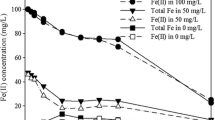Abstract
The coprecipitation of selenium(IV) (Se) with iron(III) (Fe) is a widely practiced method for the removal of Se from mineral processing effluents, but the effect of gypsum as a major secondary mineral on the iron-selenium coprecipitation process is still of concern. In our work we first investigated the effects of pH, Fe/Se molar ratio and the neutralizing agent on the removal efficiency of Se by iron-selenium coprecipitation method. The developed two-step Fe-Se coprecipitation method (Fe/Se molar ratio of 4) was superior to the one-step Fe-Se coprecipitation method at pH 4 using CaO as base in terms of the stability of the generated Fe-Se coprecipitates. Raman experimental results indicated the iron-selenium coprecipitates had the by-product of calcium selenite. We then investigated the effect of incorporation of Se into gypsum on the coprecipitation process at different pHs. The fourier transform infrared spectroscopy (FTIR), x-ray diffraction (XRD), and scanning electron microscopy (SEM) of the calcium-selenium coprecipitates showed that the Se incorporated into the structure of gypsum at pH 8–10. Therefore, this work has important implications for the development of new technologies for efficient Se removal.


Similar content being viewed by others
References
Ackerman JT, Eagles-Smith CA, Herzog MP et al (2016) Maternal transfer of contaminants in birds: Mercury and selenium concentrations in parents and their eggs. Environ Pollut 210:145–154
Abdel-Wahab A, Batchelor B (2007) Interactions between chloride and sulfate or silica removals from wastewater using an advanced lime-aluminum softening process: Equilibrium Modeling 79:528–535
Bakather OY, Ahmad KF, Ihsanullah et al (2017) Enhanced adsorption of selenium ions from aqueous solution using iron oxide impregnated carbon nanotubes. Bioinorg Chem Appl 2017:1–12
Cui W, Li P, Wang Z et al (2018) Adsorption study of selenium ions from aqueous solutions using MgO nanosheets synthesized by ultrasonic method. J Hazard Mater 341:268–276
Frost RL, Keeffe EC (2009) Raman spectroscopic study of the selenite mineral: ahlfeldite, NiSeO3·2H2O. J Raman Spectrosc 40:509–512
Francisco PCM, Sato T, Otake T et al (2018) Mechanisms of Se(IV) co-precipitation with ferrihydrite at acidic and alkaline conditions, and its behavior during aging. Environ Sci Techol 52:4817–4826
Gui M, Papp JK, Colburn AS et al (2015) Engineered iron/iron oxide functionalized membranes for selenium and other toxic metal removal from power plant scrubber water. J Membr Sci 488:79–91
Guo B, Sasaki K, Hirajima T (2017) Selenite and selenate uptaken in ettringite: Immobilization mechanisms, coordination chemistry, and insights from structure. Cem Concr 100:166–175
He Y, Xiang Y, Zhou Y et al (2018) Selenium contamination, consequences and remediation techniques in water and soils: A review. Environ Res 164:288–301
Jordan N, Ritter A, Foerstendorf H et al (2013) Adsorption mechanism of selenium(VI) onto maghemite. Geochim Cosmochim Acta 103:63–75
Jem VDP, Enrico TN, Raj GN et al (2019) Graphene oxide nanocomposite hydrogel beads for removal of selenium in contaminated water. Pasan Chinthana Bandara Appl Polyr Mater 1:2668–2679
Leyva D, Estévez J, Montero A et al (2012) Separation and determination of selenium in water samples by the combination of APDC coprecipitation: X-ray fluorescence spectrometry. J Radioanal Nucl Chem 291:699–705
Lin J, Chen N, Feng R et al (2020) Sequestration of selenite and selenate in gypsum (CaSO4•2H2O): Insights from single-crystal EPR and synchrotron XAS study. Environ Sci Technol. https://doi.org/10.1021/acs.est.9b05714
Mccloskey C, Jettinghoff T (2009) Selenium removal from refinery wastewater via iron coprecipitation in a mobile Clarifier. Proc Water Environ Feder 2009:439–445
Moon DH, Grubb DG, Reilly TL (2009) Stabilization/solidification of selenium-impacted soils using Portland cement and cement kiln dust. J Hazard Mater 168:944–951
Ma J, Wang Y, Zhou L et al (2013) Preparation and characterization of selenite substituted hydroxyapatite. Mater Sci Eng C 33:440–445
Nakamoto K (1986) Infrared and Raman spectra of inorganic and coordination compounds, 4th edn. John Wiley & Sons, New York
Namara CM, Torroba J, Deacon A (2015) New smopex ion exchange materials for the removal of selenium from industrial effluent streams. Johnson Matthey Tech 59:334–352
Natasha SM, Niazi NK et al (2018) A critical review of selenium biogeochemical behavior in soil-plant system with an inference to human health. Environ Pollut 234:915–934
Peravadhanulu A, Rao PDP, Mathur GP et al (1979) Gypsum and Selenite Minerals & Mining 7:333–339
Pan B, Xiao L, Nie G et al (2010) Adsorptive selenite removal from water using a nano-hydrated ferric oxides (HFOs)/polymer hybrid adsorbent. J Environ Monitor 12:305–310
Staicu LC, Van HED, Oturan MA et al (2015) Removal of colloidal biogenic selenium from wastewater. Chemosphere 125:130–138
Su C, Suarez DL (2000) Selenate and selenite sorption on iron oxides: An infrared and electrophoretic study. Soil Sci Soc Am J 64:101–111
Vlaev LT, Genieva SD, Georgieva VG (2006) Study of the crystallization fields of nickel (II) selenites in the system NiSeO3-SeO2-H2O. J Therm Anal Calorim 86:449–456
Wang S, Zhang D, Li X et al (2018) Arsenic associated with gypsum produced from Fe(III)-As(V) coprecipitation: Implications for the stability of industrial As-bearing waste. J Hazard Mater 360:311–318
Zhang D, Yuan Z, Wang S et al (2015) Incorporation of arsenic into gypsum: Relevant to arsenic removal and immobilization process in hydrometallurgical industry. J Hazard Mater 300:272–280
Acknowledgments
This project was supported by the National Key Research and Development Program of China (2017YFD0800301). We gratefully acknowledge the help of Dr. Alberto Gomez Mario for his valuable suggestions in language polish.
Author information
Authors and Affiliations
Corresponding author
Electronic supplementary material
Below is the link to the electronic supplementary material.
Rights and permissions
About this article
Cite this article
Wang, H., Jiang, R., Wang, B. et al. The Effect of Gypsum on the Fixation of Selenium in the Iron/Calcium-Selenium Coprecipitation Process. Bull Environ Contam Toxicol 106, 121–125 (2021). https://doi.org/10.1007/s00128-020-02881-2
Received:
Accepted:
Published:
Issue Date:
DOI: https://doi.org/10.1007/s00128-020-02881-2




